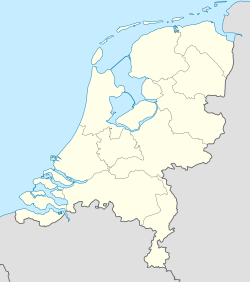Amsterdam Weesperpoort | |||||
|---|---|---|---|---|---|
 The station in the 1930s | |||||
| General information | |||||
| Coordinates | 52°21′36″N4°54′31″E / 52.36000°N 4.90861°E | ||||
| Line | Amsterdam–Arnhem railway | ||||
| History | |||||
| Opened | 28 December 1843 | ||||
| Closed | 14 October 1939 | ||||
| |||||
Weesperpoort (Dutch: Weesperpoortstation) was a railway station in Amsterdam, the Netherlands. It opened in 1843 as the terminus station in Amsterdam of the railway line to Utrecht and Arnhem. Over the years, the station was expanded as new services started, including international trains and a tram to the Gooi. Weesperpoort was no longer the terminus in Amsterdam from 1889 onwards; trains coming into the station would reverse and continue to the newly built Amsterdam Centraal station. The station was closed in 1939 after it became obsolete with the opening of the Amstel station nearby, with its demolition taking place soon after.








